
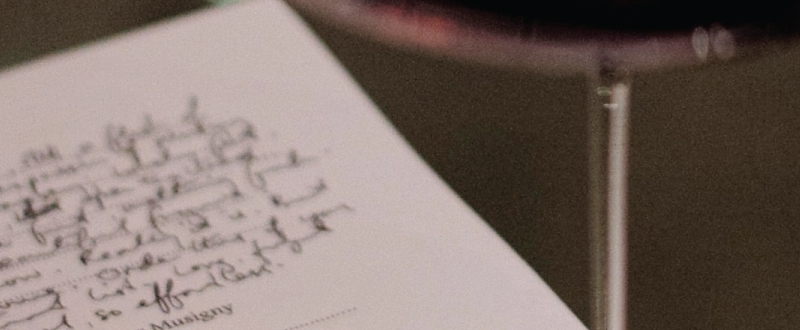
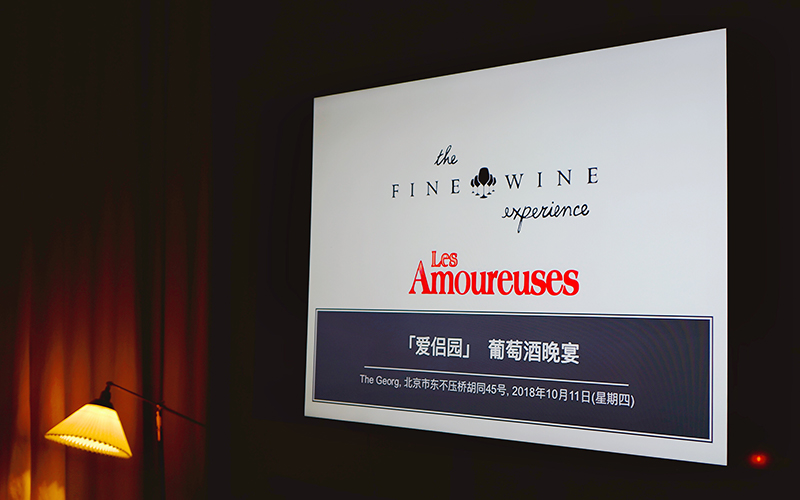
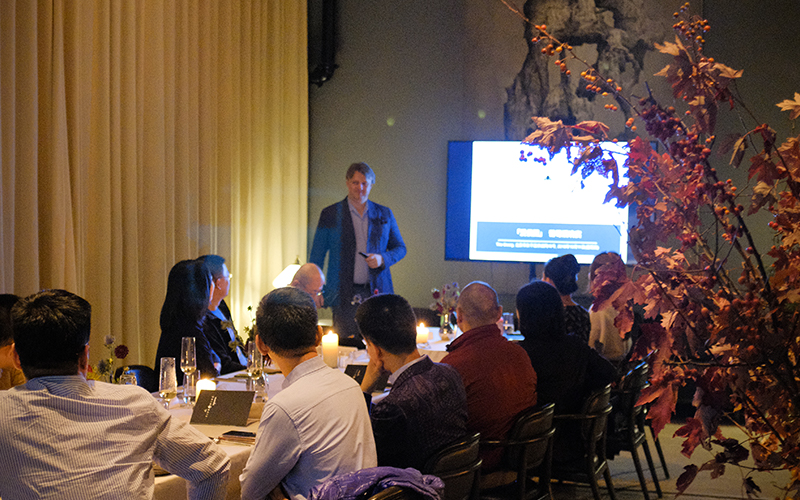
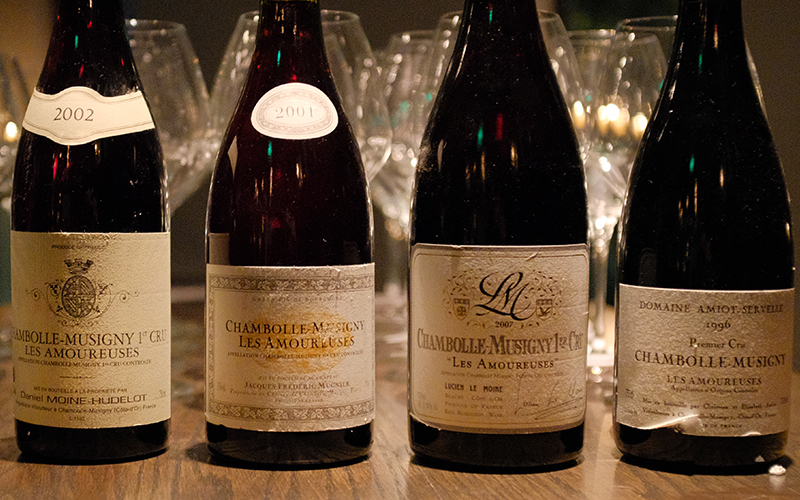

© Linden Wilkie
A group of us recently assembled in Beijing at Georg Jensen’s restaurant ‘The Georg’ last week for a reasonably comprehensive look at Chambolle-Musigny 1er Cru ‘Les Amoureuses’. As hosts for the evening, The Fine Wine Experience served eleven different producers across eleven different vintages, allowing us to ask ourselves – what is Amoureuses, and do we like it?
The 5.4ha premier cru ranked vineyard of Les Amoureuses nestles in by Musigny in Chambolle-Musigny. A small part of it sits up slope of the small road that leads to the Clos Vougeot. In four (and a bit) pieces, owned by Drouhin, Mugnier, Bertheau, Pousse d’Or (formerly by Moine-Hudelot), it lies between the grand cru Les Musigny to its south, the 1er cru Les Chabiots (e.g. Lignier, Serveau, Magnien) to its north, and the lesser seen (e.g. Magnien) 1er cru Les Borniques up slope to the west. The much larger portion of Les Amoureuses continues downslope from this small road, finishing just above the little village of Vougeot to its east, with the 1er cru Les Petits Vougeot (whose expression seems to have more in common with Amoureuses than it does with Clos Vougeot) separated by a thin strip of land, to its south, and the 1er cru Les Hauts Doix (a Groffier specialty) to its north.

What we have always known – looking at the surface of Les Amoureuses – is that its soil is thin, and it is ‘broken’ two thirds of the way down by a large fault – a drop of a few metres to the downslope portion. (And just to the south of this fault, lies an ancient quarry). But an exciting development recently has been the geological survey maps produced by Françoise Vannier-Petit. Through her work – very recently published - we now know much more about the bedrock in Amoureuses. Revealed is that it shares the same Jurassic geology as Les Musigny and Les Petits Musigny – Comblanchein limestone (though the soil is generally thinner in Les Amoureuses). This much has been traditionally known – most sources state that Les Amoureuses lies on Comblanchien limestone. However, below the level of the fault we now know that the bedrock is the slightly more porous Premeaux limestone. This Premeaux bedrock extends to (the aforementioned) Vougeot 1er Cru ‘Les Petits Vougeot’, and Chambolle-Musigny 1er Cru ‘Les Hauts Doix’ on Amoureuses’ flanks at the same point in the slope. Then, at the bottom of the Amoureuses vineyard, just above the Vougeot village itself, the bedrock changes to a third type - Marls containing tiny fossilized oyster shells formed in the Jurassic period. It’s ostensibly the same ‘white’ soil as found on the upper side of the grand cru vineyard Bonnes-Mares, so we should be careful not to view this as some sort of downslope ‘downgrade’, but it is a significant change.
On top of this my colleague Carine painstakingly overlaid a grid showing all of the pieces of Amoureuses (from the government records – the cadastre), and which domaine owns which, so that it is possible to know which producer is on which soil. In the back of my mind then in this tasting, since we had assembled a good number of the domaines exploiting Les Amoureuses, was: is the change of soil discernible in the wine? The answer is no, at least not by me, not on this occasion with a different vintage per domaine to compare. But for those who like to pursue this sort of question further, it is now possible.
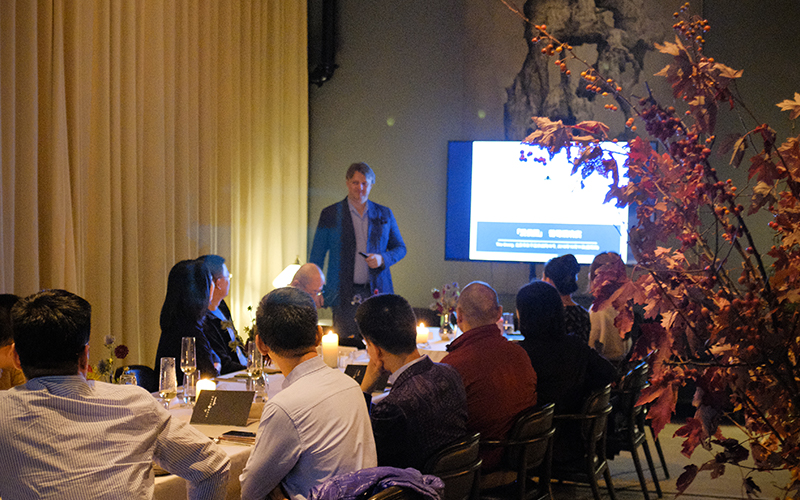
Indeed, it would be one of my conclusions at this tasting that Amoureuses wines wear their vintages on their sleeves (though I was impressed by the relative freshness in Drouhin’s ’03). Reflecting on any common characteristic in the wines, it seemed generally that the wines expressed a ‘pretty’ and floral sort of character we would normally associate with Chambolle-Musigny (and also find in Musigny itself to a great extent), but that it is more delicate than Musigny, offering much less depth and power, but indeed something nonetheless seductive or alluring all the same. But, unlike Musigny (or, for example, Chambertin), Amoureuses seems more malleable to the impact of vintage, so you had better drink it in a vintage you really admire already. Secondly, producer makes quite an impact (doesn’t it always?). I thought the producers who best conveyed the terroir were Roumier, Drouhin, de Vogüé, and Mugnier. Bertheau, Fourrier (négoce) Amiot-Servelle and Moine-Hudelot did too, to an extent, while Lucien Le Moine seemed more ‘producer-signature’ in style. That said, this tasting was one in which the producer factor had to be judged through the lens of a single vintage. Vintages like ’15, ’09 (rich, ripe), and ’96 (cool, crisp) did leave their imprint firmly. If anything, though, there was in common across almost all of these wines a ripe sort of sweetness – like the seductive intensity of small fragrant strawberries at the height of the season. There seemed no ‘bad’ Amoureuses, but as this is an expensive wine (even within the context of contemporary Burgundy prices), this is something to understand before you spend your money. Personally, for my own cellaring/drinking, I think I would target classic, transparent vintages like ’16, ’13, ’12, ’10, ’08, ’02, and ’01. That said, the ’03 Drouhin ’00 Roumier, and ’98 de Vogüé were my favourites – all from less classic years, but I think that had a lot to do with the producers themselves. I appreciate that this conclusion is something of a contradiction! I suppose then what I am saying is that you should find a producer you like (1), and then err toward the vintages you like (2), because the vintage style will be fully imprinted.
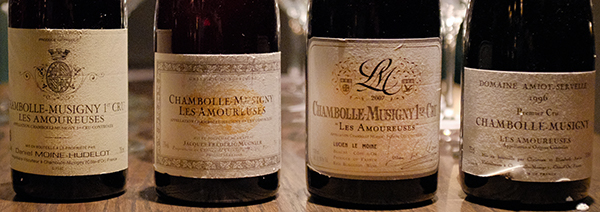
Why not? I have no doubt that Les Amoureuses is capable of the level of quality we find in very good grands crus like Corton-Bressandes, Ruchottes-Chambertin, or Clos des Lambrays, for example. If the market is an indicator, then for sure, Les Amoureuses is a grand cru in all but law. But I cannot recall a time when I have tasted a Musigny and Amoureuses side by side from the same producer and vintage and thought “the Amoureuses is the better of these two”. It lacks the depth, the power and the velvet. If we take the 2001 vintage, and Domaine Mugnier as an example, I have had in the past Mugnier’s 2001 Musigny – a truly magnificent wine. The 2001 Les Amoureuses tonight was lovely, showing off Mugnier’s knack for supple and subtle wines of appealing fragrance. The Amoureuses had a noticeable enough lightness in Mugnier’s ’01, that I’m sure even without tasting them side by side that the extra dimensions of the Musigny would be apparent.
That said, the debate about whether Les Amoureuses should be a grand cru is perhaps not the most interesting question after all. Does Cros Parantoux need to match Richebourg for it to warrant attention? No. Richebourg proves its place near the top of the grands crus through the completeness of its dimensions. The exalted premier cru Cros Parantoux lacks some of these (it is concentrated but lacks fat), but emphasizes others in the process (incredible minerality, for example), and in doing so makes itself especially interesting for that emphasis.
So, then, to re-phrase, is Amoureuses worth our attention? Undoubtedly. Especially if you value a red fruit sort of sweetness, combined with perfume and minerality, and you appreciate the delicacy delivered in a more slender frame.
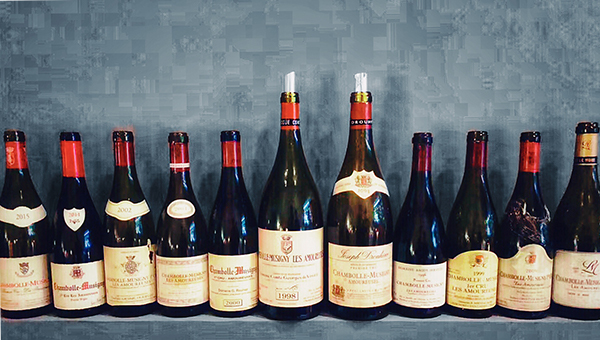
At the end of the dinner the 13 of us around the table cast 2 votes each for our favourite wines of the night. Of the 26 votes cast, the top wines were -
2000 Domaine Roumier – 6 votes, 1st place
1998 Domaine Comte Georges de Vogüé – 5 votes, 2nd=
2009 Domaine Groffier – 5 votes, 2nd=
2001 Domaine J-F Mugnier – 3 votes, 4th=
2003 Domaine Joseph Drouhin – 3 votes, 4th=
2007 Lucien Le Moine – 3 votes, 4th=
2015 Domaine François Bertheau – 1 vote, 7th
My own preferences varied a bit from this – and you can see my notes and scores below, but I think the result above is a good indicator of appeal, as 13 palates were involved.
2015 Domaine François Bertheau 91
Ripe with quite a vanillin-toned nose still; cherry and raspberry patisserie on the palate, very 2015 in feel – i.e. ripe fruit and opulence to the fore.
One vote for wine of the night.
2014 Jean-Marie Fourrier 93
One of Fourrier’s négocient offerings.
Very expressive on the nose – pure and fragrant; floral-styled on the palate, silky and seductive, long, lovely, very good.
No votes for wine of the night.
2002 Domaine Moine-Hudelot 92
Now extinct domaine, part of Domaine Pousse d’Or from around 2009.
Lovely fragrance, sweet, very floral, detailed; sweet on the palate with a touch of raisin, this is fruity, bright; on the palate a bit terrestrial rather than ethereal, this has lovely, almost candied level fruit, juicy though, delicious. I thought this wine was really lovely. (A better showing than a previous bottle I’ve had).
No votes for wine of the night.
2001 Domaine J-F Mugnier 92
Lighter colour and depth; this wine is immediately so much more high register on the nose – elegant, refined, and floating; lighter on the palate too, a bit delicate in fact, it lacks a bit of authority on the palate, which is delicious nonetheless. The winning factor here is the nose, which is so delicate and refined.
Three votes for wine of the night.
2000 Domaine Georges Roumier 95
Full colour here, bright and clear; a fine nose, precise, there’s more limestone-cool expressed here, despite the warmth of 2000, very mineral, and admirably pure; the palate is fleshy, full, pure, fruity, very round in texture and weight – indeed its fault, if there is one, is that it is a bit full on the finish. The overall intensity and purity is first rate, however.
Six votes for wine of the night, including one of mine.
2003 Joseph Drouhin (magnum) 93
Lush on the nose, full of roses in bloom, some spice, some leather, you can smell the power of the sun in 2003; big, sweet, delicious on the palate, spicy, the leather element – with a little attendant dryness in the tannins – is well in check. A natural unforced feel to the concentration, which is generous. The 2003 opulence is here, but what is so wonderful about this is that there is a real succulence as well. A personal favourite in tonight’s dinner.
Three votes for wine of the night.
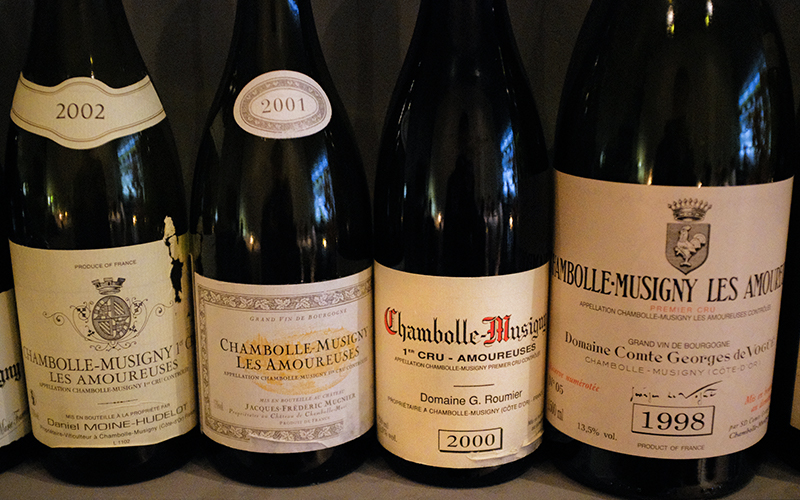
1999 Domaine Bernard Serveau -
This wine was concentrated and juicy. However, as the evening wore on and it opened in the glass, it was obvious it was marred by light TCA sadly. Another time I hope!
1998 Domaine Comte Georges de Vogüé (magnum) 94
A concentrated, deep, pure, fine, noble nose – very straight; concentrated, fine, a bit tannic at first, pure – like the ’98 Musigny from this estate. At first it felt like it was lacking the fruit depth to buffer the grip – not having Musigny’s extra depth. The tannin is mostly fully ripe, but there is a little austerity to it. However, of all the wines at the dinner tonight, this one changed the most, opening up – and sweetening – very gradually. It became clear that the equilibrium is actually very good; this is just simply still very young. The expression is noble and pure. I would give this another 10 years still (in magnum).
Five votes for wine of the night, including one of mine.
1996 Domaine Amiot-Servelle 91
A sweet, lifted candied nose of small, slightly confit strawberries; elegant, brisk, with some malic feel to its acidity (illusory) – indeed, this stays firm right to the end, not through tannin – which is resolved – but by the acidity. This wine behaves more like a white than a red in this regard. That said there is enough strawberry-like fruit in the middle to satisfy. A good wine.
No votes for wine of the night.
2009 Domaine Robert Groffier 90
The sweetness of wine biscuits on the nose, fine fruit; sweet on the palate, perhaps in its relative youth expressing a bit plainly I feel. Ripe, sweet fruit, but not the nuance I would hope for in paying up for Amoureuses. (It should be noted that this wine had many fans at our table, so do take my view with a pinch of salt).
Five votes for wine of the night.
2007 Lucien Le Moine 90
Quite open and aromatic on the nose, with an exotic edge of spiciness; sweet and juicy on the palate, there is a slightly odd lactic-like note, something a bit leesy and ‘made’ about the style of this wine. Delicious fruit, some unexpected firmness.
Three votes for wine of the night.
